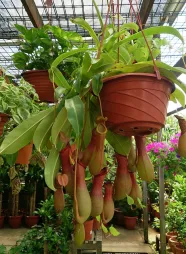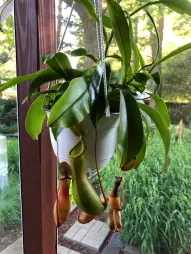Nepenthes Gaya, the spotted urn nepenthes
There's no need to look for Nepenthes Gaya in Philippine forests. It's a cultivar resulting from the crossing of three varieties of the Nepenthaceae family: N. Khasiana, N. Ventricosa and N. Maxima. The result? A plant recognizable by its mottled red urns.
How to recognize Nepenthes Gaya?
Nepenthes Gaya is a carnivorous terrestrial plant with a compact habit. In pots and indoors, it measures 50 centimetres in all directions.
The bright green leaves are leathery and elongated crescent-shaped. They grow in a rosette on the hairy stem. Each blade ends in a green and purple tendril. The trap is attached at the end. The ascidian resembles an urn or gourd. One side is purple with green flecks, the other green with dark red mottling. The two-tone entrance to the trap is covered with a nectar that attracts insects. When they land on it, flies and wasps slide to the bottom of the urn, where they are dissolved by the digestive liquid.
Nepenthes Gaya is dangerous only to insects. Its trap, like that of Nepenthes x ventrata, is passive. It is unlikely to close on your cat's whiskers or your dog's nose. Nor is the nectar it contains toxic.
Our maintenance tips
To produce its urns, your Nepenthes gaya needs light, heat and humidity. But even when these three parameters are under control, your carnivorous plant will have to adapt to its new growing conditions. You'll probably have to wait a few weeks, even months, before witnessing the birth of the traps.
Watering
Nepenthes gaya likes to keep its potting soil constantly moist. Don't wait for the substrate to dry on the surface before watering.
Water the soil with rainwater at room temperature. Don't use hard water, as it could kill your plant.
Soak the root ball until water runs off through the drainage holes. Drain off any excess water.
Drain any stagnant water from the planter or saucer to prevent root rot.
Spray
Nepenthes gaya come from tropical regions. They appreciate high humidity. To recreate it, spray the foliage with non-calcareous water at room temperature.
Repotting
Every spring, repot your Nepenthes x Gaya to give it more space.
Get a plastic pot with holes, larger than the previous one. If your Nepenthes gaya has reached its adult size, there's no need to change containers. Clean the old one and reuse it.
Fill the bottom with a light, draining substrate. You can choose a commercially available potting soil for carnivorous plants. If you want to make your own growing medium, mix 70% sphagnum moss or blond peat with perlite, vermiculite or non-limestone sand.
Plant your Nepenthes gaya and fill the pot with potting soil. Your plant loves to climb! Install a wooden stake so it can hang its aerial roots and grow straight.
Pack the substrate lightly without suffocating the roots. Rather than using your hands, tap the bottom of your pot against the table two or three times. Mist the soil with non-calcareous water and wait 24 hours before watering.
To improve humidity, place your pot on a saucer filled with moist clay balls. You can also cover the surface of the substrate with live sphagnum moss.
Prune
To encourage the growth of your Nepenthes gaya, prune regularly.
Cut urns completely dry using a clean pair of scissors or pruning shears.
Shorten the stem if it dries out. Cut off the brown part and keep only the green.
Cutting
Cutting is carried out during the strong growth phase, generally in spring and early summer.
Surround the base of your cutting (the lower part) with living sphagnum moss. You can form a ball around the stem or plant your young shoot in a plastic pot-bin lined with sphagnum moss.
Then provide your Nepenthes gaya with a warm, moist atmosphere. If you don't have a bathroom with a window, grow your cutting in a smothered environment. Place it in a terrarium or in a zipped food bag, which you open for a few minutes each day.
Disease / Threat
Information
| Family | Nepenthaceae - Nepenthaceae |
| Type | Nepenthes - Nepenthes |
| Species | Nepenthes gaya - Nepenthes x Gaya |
| Lifecycle | Perennial |
| Foliage | Evergreen |
| Exposure | |
| Substrat | |
| Planting method |
In pots |
| Categories | |
| Tags |
Fritillary Soiffarde |
| Origin |
Southeast Asia |
| Hardiness (USDA) | 11b |
| Leaf color |
|
| Flower colors |
|
| Fruit color |
|
Discover plants from the same family


















